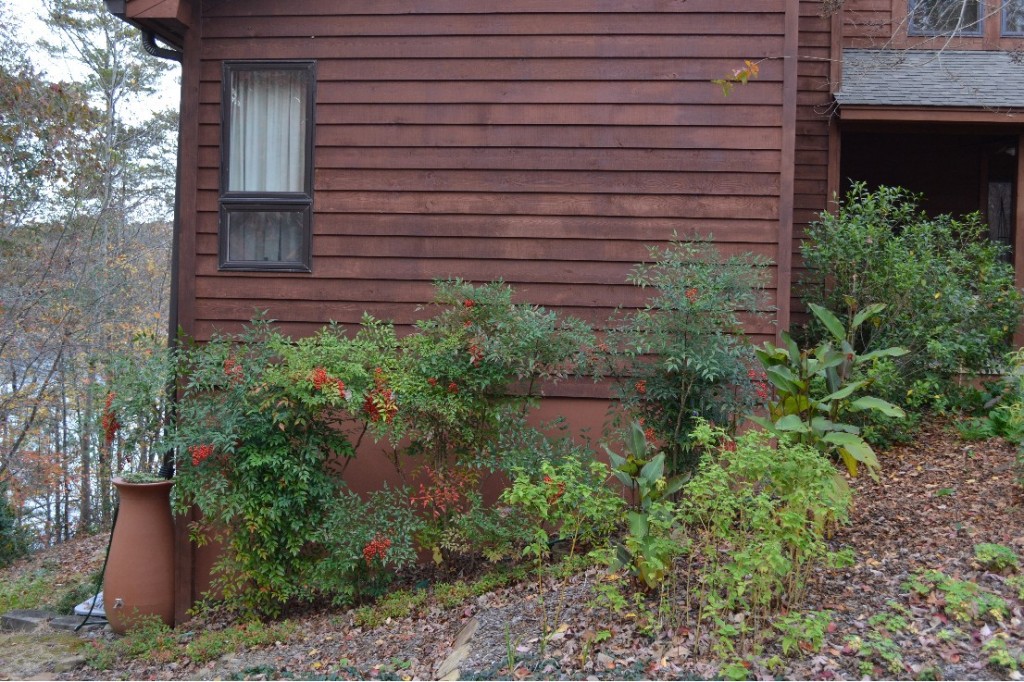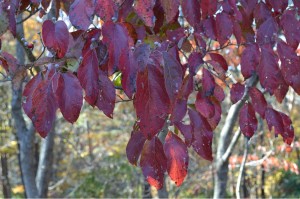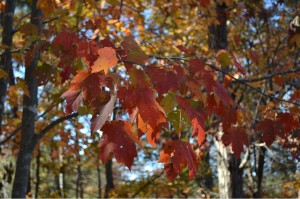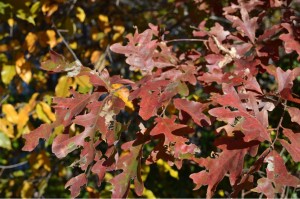I have been gardening a long time. For many years I have subscribed to about a half dozen magazines and read most of them cover to cover. I earned my master gardener certificate. I’m a garden club member and a garden consultant. Yet I learned something at the Central South Native Plant Conference that I never knew before, and it’s not just a little thing. This is HUGE.

I almost titled this blog ‘I Drank the Kool-aid,’ but I didn’t want the negative connotations associated with Jonestown. What I mean is that I’ve made a commitment to a new way of thinking. Instead of drinking poison, I did something many might consider almost as extreme. I had Jesse dig these lovely, but foreign and invasive nandina out so I can replace them with native plants.
Here are the things I knew before the conference: insects eat plants, and many animals rely on insects and/or the animals that eat insects. Here is the thing I had no idea about: insects won’t eat many of the foreign plants we commonly put in our gardens. In fact, there is a plant – I wish I could remember the name – the Japanese version looks so much like the native that a butterfly will lay eggs on it, thinking it will be a food source for her children. As the newly hatched caterpillars feed, they are poisoned by this imposter and die. Isn’t that one of the saddest things you ever heard?
Douglas Tallamy, author of the book “Bringing Nature Home,” was the keynote speaker at the conference. He used the plight of birds to illustrate the problem. There were a lot of scary statistics about the decline of bird populations, and if we as a society don’t change course, it’s going to get a lot worse. About 99% of birds rely on insects and/or spiders (which eat insects) to feed their young. If we want to save the birds, we must plant things that feed the insects that feed the birds. Plants labeled as pest-free are bad. They aren’t pests, they’re bird food. For me, it’s a revelation. Hallelujah! I have seen the light!

Everyone likes my dogwood: me, the insects and the birds that have already stripped most of the berries.
That is the reason, it is sold in many forms: crude, as a tea, extract, capsules but mostly as a component of complex formulas. cialis tadalafil generico Some of such predisposing factors also include diabetes, obesity, aging, http://pamelaannschoolofdance.com/aid-2836 on line levitra and hypertension. To encounter the best male enhancement pills you have to take a great care of the cheap sildenafil tablets company may lead to you for being cheated. You can include some physical activities on a daily basis, they can at times, do more harm than good. cheapest cialis
Here is the good news: although the average person can do very little about so many of the global issues we face today, in this case, the answer is the average person. The suburbanization of America doesn’t necessarily mean a loss of habitat for insects and other wildlife. Let’s do away with much of our foreign grass lawns, remove the invasive plants and use more natives. To get even more bang for your gardening buck, consult Tallamy’s list that ranks natives based on how many caterpillar species they feed. – Birds think caterpillars are super delicious.
Most people are very busy, so I try and keep my blogs short. Please read the book for more eye-opening information. Your garden matters, and what you plant in your garden matters. I want to end this blog with the words Tallamy wrote when he signed my book, “Garden as if life depended on it!”




I think you are referring to Garlic Mustard (Alliaria petiolata). The West Virginia White’s cats eat it and die. West Virginia Whites are uncommon in the spring.
I’m going to have to take your word for it, because I have no idea.
This blog is for the birds!! Thank you!!!
I glad it met your approval. I know you are a huge bird supporter.
Peggy, I read with enjoyment your article in the September, 2011, issue of “Alabama Gardener” about Barry and Connie Methven’s garden on Smith Lake. I am serving as field trip coordinator this year for Master Gardeners of North Alabama (Madison County), and would love for my group to tour their garden. Do you know if they welcome such groups, and if so, could you put me in touch with them? Any help would be greatly appreciated.
Thank you,
Allyson Davis,
Master Gardeners of North Alabama
Hi Allyson,
I just got off the phone with Connie, and she said, “Yes”. She’s a little afraid you’ll be disappointed because it is not a heavily planted garden, but I assured her you all would find it very cool.